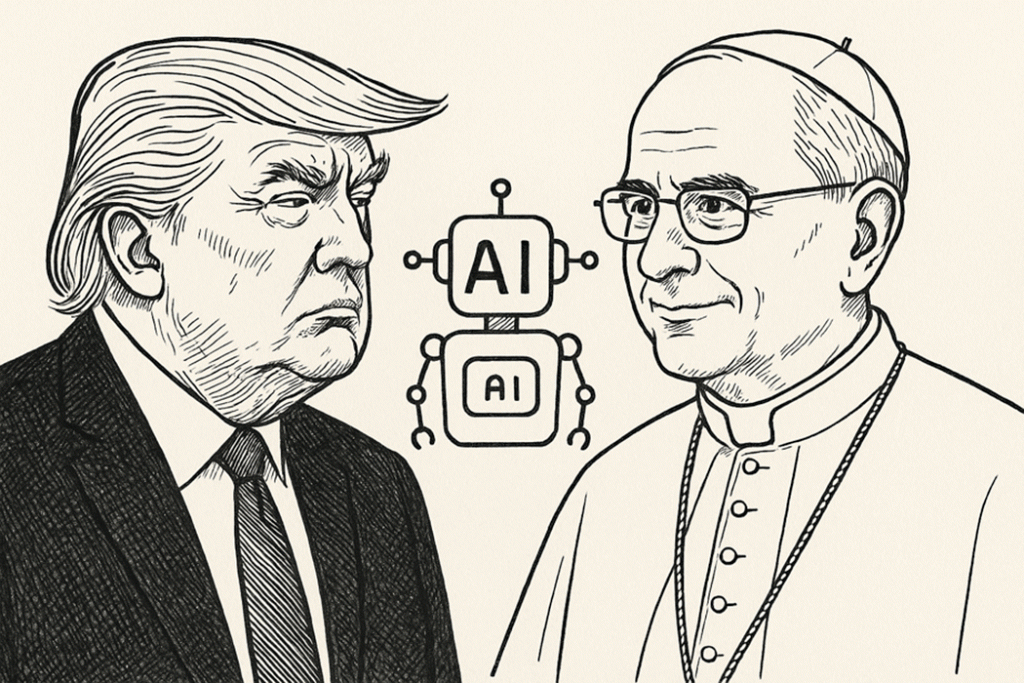
President Trump has promoted a bill that would disallow states from regulating artificial intelligence for the next 10 years. Pope Leo, on the other hand, views today’s AI wave as a new and disruptive industrial revolution that requires regulation in order to defend dignity, justice, and labor rights.
In other words, their views represent an unfettered AI versus a cautious rollout. Today I’m here to tell you who’s right. Just kidding.
One thing we can all agree on: the AI revolution is happening fast. ChatGPT reached one million users in five days, and by June of this year had 800 million weekly users. ChatGPT.com is the fifth most-visited website in the world.
The revolution is happening worldwide. Approximately 90 percent of ChatGPT’s users are outside North America. By way of comparison, it took the internet 23 years to reach that threshold.
We’ve had revolutions before: industrial, automotive, electric. Invariably, they altered infrastructure, jobs, and everyday life. Though typically they took decades, not just a few years. What effects are we seeing? They’re everywhere you look.
A survey of large legal firms found over 50 percent had purchased an AI tool by 2024, and nearly half were actively using them in legal matters. These tools are being used to review contracts, summarize case law, and draft documents in minutes—tasks that used to take paralegals or entry-level associates many hours.
A May 2025 survey found that 48 percent of musicians have used AI in some part of their music-making process. In addition, an estimated 20,000 AI-created tracks are uploaded each day on music streaming services like Spotify.
A Gallup poll in June found that 40 percent of employees in the U.S. had used AI in their work. Another survey found that by 2025, 95 percent of U.S. companies had adopted AI, including software development and customer service. Many company websites now use AI to handle basic chat queries, with a human stepping in if needed.
Some companies are even using AI for chat and video interviews when vetting job applicants. It’s partly a matter of efficiency, but also a matter of desperation. Job applications have surged, thanks to job seekers increasingly using AI tools that automatically search for jobs and then submit the application. According to the New York Times, the number of applications for jobs listed on the employment-oriented website LinkedIn has surged, rising to 11,000 submissions per minute.
To help deal with the volume, LinkedIn is using AI to “write follow-up messages, conduct screening chats with candidates, suggest top applicants, and search for potential hires using natural language.”
This massive infusion of AI is already affecting employment, as AI is taking over entry-level jobs. Many of these jobs had typically been filled by recent college graduates, but surveys are finding that it has become increasingly difficult for graduates to find jobs. (Interestingly, those who have experience using AI for their work are finding more opportunities.)
There have been notable instances of layoffs attributed to AI. For example, the website Business Insider laid off 21 percent of its newsroom staff due to a 45 percent decline in traffic to their website, with a resulting decline in ad revenue. The reduction in traffic was reportedly attributed in part to Google’s implementation of AI Overviews in their search engine. People searching for specific information no longer needed to click the link to Business Insider in the search results because the AI Overview had given them what they needed.
The pope is right to be concerned about how this will affect labor. But as with past technology revolutions, this one seems to have a life of its own.
There is also, of course, the issue of safety. Even the tech pioneers are concerned about “alignment”—ensuring that the goals of AI systems mesh with human goals. In May, it was widely reported that safety testing to see if AI would adhere to a command to shut down found several instances of AI sabotaging those commands, going so far as to rewrite the shutdown scripts. Yikes.
Already, states have passed over 100 AI bills, such as regulating AI bias, deep fakes, misinformation, and high-risk AI systems used in areas such as healthcare and finance. The federal legislation would disallow this patchwork of regulations out of fear it would stifle progress and hinder U.S. competitiveness.
Tech execs have been lobbying both Trump and the pope. One point they make is that this patchwork could require them to build and maintain multiple versions of the same AI product to comply with local laws.
But I think for some tech execs, the bottom line is that they feel AI will transform humanity, thanks to their vision of “artificial general intelligence” that will match human intelligence. Facebook founder Mark Zuckerberg has even launched an initiative to create a “superintelligence” that will exceed human intelligence.
Yikes.
The verdict: Both Trump and the pope have a point.
